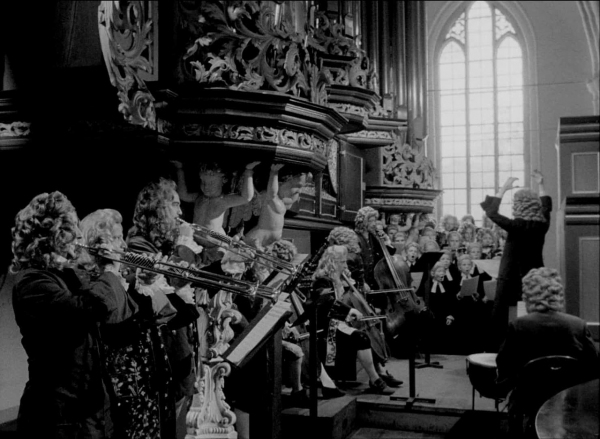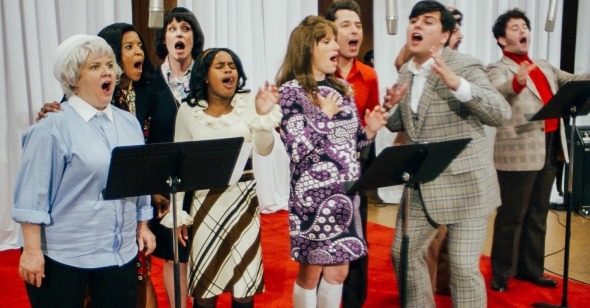In this new weekly column, Connected, one writer will send another a new piece of writing about a film they have been watching and pondering over, in the hopes that this will prompt a connection—emotional, thematic, historical, or analytical—to a different film the other has been watching or is inspired to rewatch. This ongoing column will be in the spirit of many past Reverse Shot symposiums, in which writers found connections between seemingly disparate cinematic works, and it will also help us maintain personal connection among our writers and our readers at this uncertain moment.
The Chronicle of Anna Magdalena Bach
Here’s a connection. The default question I am asked by fellow film lovers during the lockdown is: “What are you watching?” My questioners have all manner of prepared answers to this: a film randomizer, iffy horror sequels, Cary Grant pictures. To my shame, I have none. Until a few days ago, the closest I got to watching a film in its entirety since the unpleasantness began was Chaplin’s The Gold Rush, aborted at the first sight of Georgia Hale because I wasn’t ready to suffer.
Why am I having so much trouble letting film back into my life at a time when it should be the greatest redeemer? Am I a bad cinephile? Perhaps the directness and objectivity of cinema—its ever-opening window onto the real world, so vital to me in peacetime—is too much now. Cinema carries a deep connection to the recent past (before the unpleasantness), which disconcerts. I need something to have changed: a more abstract, ethereal experience that will leave me alone with my own thoughts and not those of others. Music provides this in spades, with J S Bach foremost. The cantatas, masses, concertos, oratorios; the organ toccatas, motets . . . the Passions. Bach’s incorruptibility and rigor, producing something so infinitely sublime and personal from something so geometric, is what I crave.
There are plenty of ways back into cinema by this route. Bergman, for one. Or Malick. (So many recent releases dissolve in the mind now when compared to his A Hidden Life, and not just for his lacerating use of Dvořák and Handel). One film, though, imposes itself: Jean-Marie Straub and Danièle Huillet’s 1968 The Chronicle of Anna Magdalena Bach, which records not only the inalienable splendor of Bach throughout but also presents an awesome cinematic singularity. It is—as far as I can tell—the only concert film ever made outside of the documentary format. For while each performance is recorded in a single take and unaltered, with numerous imprecisions and flaws left in, performers in period costume take the roles of Bach, his wife and his performers at Leipzig. Despite the efforts of many artists and historians, there is no actual “chronicle of Anna Magdalena Bach,” as almost none of her words survive. The diary entries that narrate the action are invented by Straub and Huillet, compiled from snippets of the contemporary here and there.
This film arrests and purifies by its refusal to add anything textural to the music itself: the camera is static, the actors expressionless. Narration by Anna Magdalena (Christiane Lang) describes the end of Bach’s life and lapse into financial hardship and blindness. Occasional meditative tableaux of nature—Straub’s response to Griffith’s complaint that modern films lack “the beauty of the wind in the trees”—punctuate the pieces, but the breath of life comes from the music itself. Beyond a desire to depict harmonic purity (to make a film “of” Bach’s music rather than “about” it), a second preoccupation of Straub’s emerges: his philosophy of acting, applied to professional musicians recast as actors. (Straub was the more vocal and public of the two figures and concentrated primarily on direction and image, while Huillet co-wrote, managed the production design, and ruled the editing suite).
The Dutchman Gustav Leonhart was a harpsichordist of renown and a scholar, responsible for colossal strides in the use of period instruments in modern repertoire. He bore no physical resemblance to Bach but was cast for his interiority and prowess at the keyboard. During an early rehearsal of his performance of the “Italian Concerto in F Major,” Straub interrupted a bewigged Leonhart mid-flow with one of the most baffling notes that can ever have been given to a lead actor in the history of motion pictures: “You’re trying to be too naturalistic!” Leonhart had sensibly imagined how Bach would have felt when performing his concerto for the first time, but Straub was having none of this. He wanted Leonhart to concentrate on his own performance of the piece. He needed to capture that fear, which could only ultimately come from the camera rolling and the knowledge that there was only one take. In that sense, The Chronicle of Anna Magdalena Bach is a documentary—about performance—an extreme statement of the views of Renoir and Pialat, who believed all films were documentaries about the processes of their own making.
Victor Hugo observed: “Music expresses that which cannot be put into words and that which cannot remain silent.” This film reflects, passionately and even somewhat aggressively, Bach’s artistic force. Nothing verbal or aesthetic therein is expressed with the slightest emotion—even the musical performances are resolutely straightforward—because everything is contained in the music and thereby in us. By connecting to nothing, this music connects everyone and everything. —Julien Allen
“Original Cast Album: Co-op” (Documentary Now!)
Hi Julien! One thing I was most struck by in your essay, which is not to discount your characteristically articulate and concise accounting of The Chronicle of Anna Magdalena Bach, a film I treasure above the rest of its co-authors’ forbidding corpus, is the idea of being a “bad cinephile.” Of all the things demanding reflection and/or action in a moment of constant, ambient stress—and, for many, a grueling but necessary form of compartmentalization between necessity and pleasure—worrying about maintaining some sort of high level of home viewership, whether privately or performatively (on Letterboxd, or Twitter, or wherever) seems absurd.
Except, of course, that it isn’t. As I happen to believe that we are who we are regardless of the surrounding context, and also that extreme situations of all kinds tend to deepen rather than diversify patterns of thought and behavior, it’s not surprising that I’ve also been consumed of late by questions of what to watch, and why, and when. (As your kids are all considerably older and more self-sufficient than mine, I’m going to assume that “when” is a less pressing issue for you than it is for me, though I hope everybody is either sharing the family television or making do with laptops; for the twelve hours between Lea’s breakfast and bedtime, our living room set is either turned off or streaming Shaun the Sheep.) But where you describe being drawn to a work of extreme rigor—a film that commands and demands total attention, including and especially in musical sequences that are, as you say, eloquent despite their lack of language—I have found that, work assignments notwithstanding, I’ve been drawn toward things that make me laugh—i.e. the same kind of casual, immediately rewarding late-evening viewing I favored before the imposition (here, there, and everywhere) of lockdown.
I mean, I could try to draw a tortuous analogy between The Chronicle of Anna Magdalena Bach, a hybridized biopic-slash-performance piece that doubles, as you describe, as a documentary of its actors, and the meticulous, methodical period and textural re-creations of Documentary Now’s season three episode “Co-op: Original Cast Recording,” which spoofs D.A. Pennebaker’s 1970 vérité classic Original Cast Album: Company—itself a fly-on-the-wall observation of the recording of the soundtrack to Stephen Sondheim’s landmark Broadway musical. I could, but I won’t, because not even the psychic trauma of a global pandemic justifies that degree of kamikaze interpretive leap.
Instead, I’ll pick up your final thread about music connecting everything and say that while luxuriating in the Documentary Now team’s typically expert and excellent formal and tonal parody—an affectionate yet straight-faced form of re-creation made even more amazing in this episode by the authentically Sondheim-ian songs penned by Eli Bolin, Seth Meyers, and John Mulaney (who also appears onscreen as a thinly veiled, sleekly turtle-necked version of the maestro)—I found myself moved by Renée Elise Goldsberry’s rendition of the (intentionally) ridiculous song “My Home Court,” which begins with a series of strained tennis metaphors before transitioning into a hymn to tacky seventies interior design (“the brown and the beige and the brown and the beige”). Not moved by the song itself, which is, as mentioned earlier, utterly silly and eerily on-point as a satire of Sondheim’s slyly staccato rhyme schemes, but by the sheer exuberance of Goldsberry’s singing and performance, which exists at the same high level as her Tony Award–winning work in Hamilton. Her brilliance contradicts the short’s narrative conceit that the apartment-themed musical “Co-op” is a helpless, abject flop while consolidating its larger point: that musical theater has a uniquely spacious capacity for joy and delight.
Because Tanya has not seen Original Cast Album: Company, we quickly switched over to YouTube to watch Dean Jones’s glorious performance of the musical’s climactic “Being Alive,” which was excerpted in James Lapine’s 2013 documentary Six by Sondheim and revived last year as a conversation piece by Adam Driver’s rendition at the end of Noah Baumbach’s Marriage Story. No matter who’s singing it, what “Being Alive” interrogates— via the same precisely sequenced, essayistic approach as Company’s other standouts, “You Could Drive a Person Crazy” and “The Ladies Who Lunch”—is the double-edged nature of isolation: the thin line between the freedom endemic to independence and the creeping, existential terror of lacking a companion: “someone to sit in your chair, to ruin your sleep.” The equation of monogamy as a form of cozy claustrophobia is a musical-comedy staple (kidded grimly at the end of Bob Fosse’s version of Pippin, whose protagonist concedes to being “trapped...but happy” at the end of his trials) and by no means the universal truth it’s grasping to be. But on the night that we were watching it, Jones’s closed-eye belting of the title phrase hit me like a proverbial ton of bricks, shocking me into sober awareness and humbled gratitude for the things that I have. —Adam Nayman

